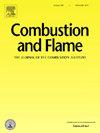Iron particles in air burn in heterogeneous combustion mode and the flame speed is very sensitive to particle size. Previous numerical work on the propagation of flames in iron dust was based on average particle sizes. However, in practice, experiments are conducted with particle size distributions (PSD). This makes it challenging to compare different experiments as the samples used in those studies vary (the average particle size might be similar but not the particle size distribution). It is the aim of the current work to provide insight into the effect of particle size distribution on flame propagation. This involves identifying the minimum number of discrete averaged particle sizes (bins) required in the simulations to capture the burning characteristics of the PSD. Then, flame speed and flame structure for a narrow and broad distribution are investigated. It is shown that the equivalence ratio at which the maximum flame speed occurs for certain mean particle sizes varies with the width of the particle size distribution. The difference in the flame speed between the same average particle size but different standard deviation varies as a function of (ratio between standard deviation and average particle size), not just the average particle size itself. For a constant at a particular equivalence ratio, the difference in the flame speed between PSD and mono-dispersed aerosols is approximately the same irrespective of the particle size. The effects of the smaller and bigger particles in the PSD on the flame speed and flame structure are also systematically investigated. The findings in this study confirm that the particle width of the PSD plays a crucial role and that experiments and simulations can not be readily compared if different PSDs are used.


